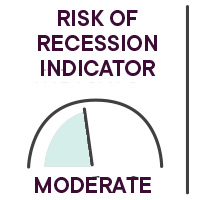The evolving meaning of “transitory”
During October, signs of inflation intensified. Where things get a bit sticky, however, is the duration implied by the word "transitory." According to the Fed and other central banks, the word indicates weaker inflationary forces in the near future, but again, the very notion of future now seems to suggest a more distant period than what was originally forecast.
Focus on the past month

Overview of global equity markets*
- The flagship index of the Canadian stock market, the S&P/TSX, advanced 5.0% in October.
- In the United States, the S&P 500 gained 4.6% and the Nasdaq, 4.8%.
- International stock markets were slightly positive during the month, with the EAFE Index up 0.1%.
- Emerging market equities were off 1.3%, while Chinese stocks rose 0.8%.
* All the percentages in this section are in Canadian dollars. Bloomberg unless otherwise indicated.
Key events

Transitory, temporary, precarious…
The "transitory" inflation that we are currently experiencing and that seems to persist is influenced, among other things, by a global supply chain that is struggling to regain its efficiency and whose costs are gradually increasing, thereby driving up prices. In addition, there is a chronic labour shortage which is difficult to fill but which should be reduced with the return of immigration. The situation is compounded by a new wave of COVID-19 that has slowed recovery efforts. Over a period of a few quarters, we can envision an easing of inflation and a return to its target level.
Obviously, technological innovations and automation, as well as the aging of the population, remain deflationary forces that are still very present and that will continue, once the transitory effects have dissipated.
Fed to reduce injections of liquidity
The level of inflation targeted by the Fed has been reached and job creation is heading in the right direction. The Fed should therefore start to taper its bond purchases in November. Its monthly purchases of $120 billion will be reduced by $15 billion per month and drop to zero in June 2022. The decision to hike rates will be made later in 2022, or even in 2023, if the economy continues to grow.
COVID-19 news
In North America, the fourth wave of COVID-19 appears to have peaked. Meanwhile, in Germany and China, the number of cases is accelerating, raising fears of another more regional wave. The global vaccination rate is still on the rise, albeit at a different pace in each country.
Employment
Since September, the number of jobs in Canada has returned to pre-COVID levels. In October, 31,200 jobs were created, less than the 41,600 expected, but mostly full-time (36,400). However, there was a loss of 5,200 part-time jobs. The unemployment rate fell from 6.9% to 6.7%, while the labour force participation was 65.3%, down from 65.5% the previous month.
In the United States, the creation of 531,000 jobs versus expectations of 450,000 and an upward revision of the previous month’s numbers are positive developments. The jobless rate fell from 4.8% to 4.6%, while the labour force participation rate remained stable at 61.6%.
Results – Canadian bonds
Government of Canada bonds across maturities posted a negative return of 1.3% for the month. (Source: Canaccord Genuity)
Performance of our funds
View the returns

Our strategic monitoring
Main risks
Here are some risks that we are closely monitoring in the current environment.
- Global supply chains are experiencing disruptions which, if they continue for several more months, could cause a rise in inflation and reduce the production of goods and services. This situation would generate an episode of stagflation.
- A rapid, sharp rise in interest rates would reduce the price/earnings ratio, which would cause stock indices to fall.
- The current energy crisis in Europe and China could slow global economic growth.
- A major cyberattack could dampen the positive sentiment generated by the reopening of the global economy and the high level of consumer confidence.
- Governments could significantly increase corporate and personal tax rates to replenish their coffers, an unlikely scenario in 2021.
Fundamental indicators
Some economic indicators we continued to follow in October.
Consumer confidence ![]()
Consumer confidence rebounded in October.
U.S. personal savings ![]()
The personal savings rate remains high, but is expected to decline over the next few months as government programs have mostly ended.
Global Purchasing Managers’ Index ![]()
The index remains above 50, indicating an increase in purchasing managers’ intentions. The index is now at 54.3, slightly higher than in September. Purchasing managers’ intentions continue to be positive, but have been declining in recent months in developed markets.
Benchmark rates in Canada, Europe and the United States ![]()
Policy rates remain favourable for an economic recovery, but should be raised over the next 12 months in North America, as the economic recovery is well underway and the employment situation has improved significantly. As for Europe, there are no plans yet to raise policy rates and it may be a while before we see a rate hike.
 |
 |
|
François Landry, CFA |
Yann Furic, B.B.A., M.Sc., CFA |
Sources: Bloomberg
The opinions expressed here and on the next page do not necessarily represent the views of Professionals’ Financial. The information contained herein has been obtained from sources deemed reliable, but we do not guarantee the accuracy of this information, and it may be incomplete. The opinions expressed are based upon our analysis and interpretation of this information and are not to be construed as a recommendation. Please consult your Wealth Management Advisor.









